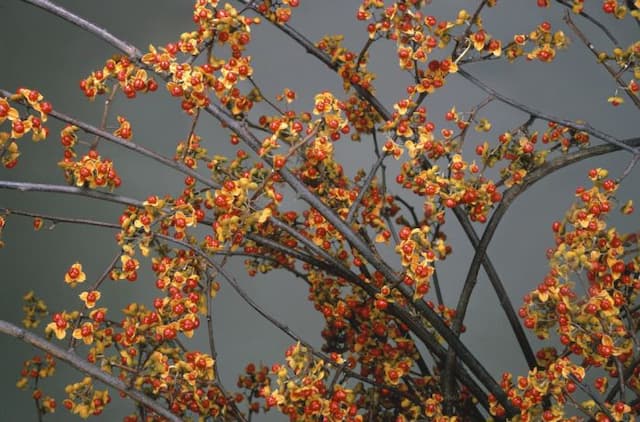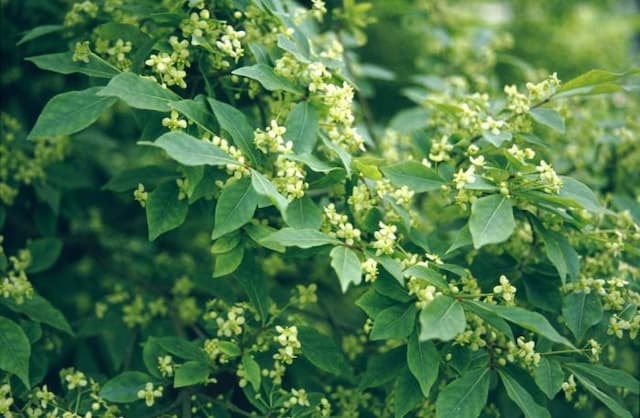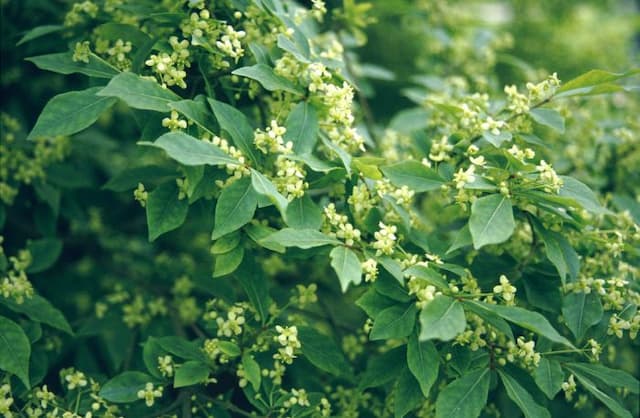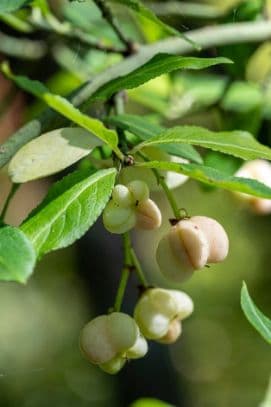Turkestan burning bush Euonymus nanus var. turkestanicus

ABOUT
The plant in question, commonly known as the turkestan burning bush, presents striking features that catch the eye. It is a deciduous shrub known for its green foliage that turns to vibrant shades of red and pink as the seasons transition from summer to autumn, creating a visual spectacle in garden landscapes. Its small, oval leaves are arranged opposite each other along the stems. When it comes to flowering, the turkestan burning bush produces modest, inconspicuous flowers that may be overlooked in favor of its stunning leaf coloration. However, these flowers give way to colorful fruits which add to the ornamental value of the plant. The fruit is typically a pink or reddish capsule that splits open to reveal orange seeds, a striking contrast against the autumn leaves. The branching pattern of the plant is dense, giving it a full-bodied appearance. The turkestan burning bush's intricate and vibrant appearance provides visual interest throughout multiple seasons, making it a favored choice for gardeners looking to add a splash of color to their outdoor spaces.
About this plant
 Names
NamesFamily
Celastraceae
Synonyms
Turkestan Burning Bush, Dwarf Spindle Tree
Common names
Euonymus nanus var. turkestanicus, Euonymus potaninii.
 Toxicity
ToxicityTo humans
The most common common name for Euonymus nanus var. turkestanicus is the Spindle Tree. This plant is considered toxic to humans if ingested. The toxic compounds present in the Spindle Tree are primarily found in the seeds, but all parts of the plant can be harmful. Symptoms of poisoning from consuming parts of the spindle tree may include abdominal pain, vomiting, diarrhea, weakness, chills, and in severe cases, can affect the heart and lead to death if ingested in large quantities. It is advised to seek medical attention immediately if poisoning is suspected.
To pets
The Spindle Tree is also toxic to pets. Like in humans, all parts of the plant, especially the seeds, contain toxic substances that can harm pets if ingested. Symptoms of poisoning in pets may include vomiting, diarrhea, abdominal pain, weakness, and potentially heart problems. These symptoms can escalate and be fatal, particularly if a significant amount is ingested. It is crucial to keep pets away from the Spindle Tree and to seek veterinary care promptly if you suspect your pet has ingested any part of this plant.
 Characteristics
CharacteristicsLife cycle
Perennials
Foliage type
Deciduous
Color of leaves
Green
Flower color
Varies
Height
2-3 feet [60-90 cm]
Spread
2-4 feet [60-120 cm]
Plant type
Shrub
Hardiness zones
4
Native area
Central Asia
Benefits
 General Benefits
General Benefits- Landscape Aesthetics: Adds visual interest to gardens with its distinctive foliage and compact growth habit.
- Drought Tolerance: Once established, the plant has a good tolerance to drought, making it suitable for water-wise gardens.
- Low Maintenance: Requires minimal care once established, which is ideal for gardeners seeking low-effort landscaping options.
- Wildlife Attraction: May attract birds and other wildlife that feed on its fruits or use the plant as shelter.
- Seasonal Interest: Offers year-round interest due to its evergreen leaves, and some seasonal color change can occur.
- Erosion Control: Its root system can help to stabilize slopes and prevent soil erosion in certain landscapes.
- Hedging and Borders: Can be used to create structured designs like hedges or borders due to its growth pattern.
- Adaptability: Capable of adapting to a range of soil types, provided the soil is well-drained.
- Cold Tolerance: It is generally resistant to cold temperatures, making it suitable for planting in cooler climates.
- Urban Tolerant: The plant can thrive in urban environments where it can tolerate pollution better than some other species.
 Medical Properties
Medical PropertiesThis plant is not used for medical purposes.
 Air-purifying Qualities
Air-purifying QualitiesThis plant is not specifically known for air purifying qualities.
 Other Uses
Other Uses- Landscape Design: Euonymus nanus var. turkestanicus, commonly known as Turkestan euonymus, can be planted in rock gardens or used for xeriscaping due to its tolerance of dry conditions.
- Bonsai Creation: This plant can be trained as a bonsai, offering an ornamental appearance in miniature form.
- Hedge Plant: Its dense growth habit allows it to be pruned into a low, formal hedge or a sculptural garden feature.
- Wildlife Shelter: The shrub provides cover and nesting opportunities for small birds and other wildlife.
- Erosion Control: Its root system can help stabilize soil on slopes or banks, reducing erosion.
- Dried Arrangements: Branches with interesting shapes or colorful autumn leaves can be used in dried floral arrangements or crafts.
- Winter Interest: The persistent fruits and winter foliage can add visual interest to a barren winter landscape.
- Barrier Planting: The spiny branches can deter animals or unauthorized access when planted as a dense barrier.
- Photography Subject: The plant's unique form and colorful fruits can make it a great subject for nature photographers, especially in autumn with its vibrant foliage.
- Cultural Significance: In some cultures, the plant may be used in traditional garden designs or symbolize certain values within landscape aesthetics.
Interesting Facts
 Feng Shui
Feng ShuiThe Spindle is not used in Feng Shui practice.
 Zodiac Sign Compitability
Zodiac Sign CompitabilityThe Spindle is not used in astrology practice.
 Plant Symbolism
Plant Symbolism- Endurance: The Euonymus nanus var. turkestanicus, also known as Turkestan burning bush, is a hardy plant that can survive in tough conditions, symbolizing the ability to endure and thrive despite challenges.
- Adaptability: This plant has the ability to adapt to various environments, representing flexibility and the capacity to adjust to changing situations in life.
- Protection: In some cultures, Euonymus species are believed to offer protection against negative influences, thus the Turkestan burning bush might symbolize a protective barrier.
- Ward off evil: With its striking appearance, the Turkestan burning bush is often thought to ward off evil spirits, symbolizing safety and the repelling of negativity.
 Water
WaterThe Turkestan euonymus should be watered deeply but infrequently to mimic its natural environment, allowing the soil to become nearly dry between waterings. Typically, watering once a week during the growing season is sufficient, depending on weather conditions. Reduce frequency to every two to three weeks during cooler months when the plant's growth slows down. Each watering session should provide enough water to moisten the soil to a depth of 8-10 inches. An average-sized Turkestan euonymus may require approximately 1-2 gallons per watering session, adjusted for size and local climate.
 Light
LightThe Turkestan euonymus prefers full sun to partial shade, thriving best with at least six hours of direct sunlight daily. A spot that receives morning sunlight and some afternoon shade would be ideal, ensuring it gets ample light without excessive heat that could stress the plant. Avoid deeply shaded areas, as insufficient light can lead to leggy growth and suboptimal foliage vigor.
 Temperature
TemperatureTurkestan euonymus is tolerant of a wide range of temperatures but flourishes in conditions ranging from 60°F to 80°F. It can survive minimum temperatures down to around 0°F, making it suitable for many temperate regions. Maximum survivable temperatures are approximately 100°F, although prolonged exposure to extreme heat may cause stress. The ideal temperature conditions for this plant are typical of its native habitat, with cool to mild temperatures preferred.
 Pruning
PruningPruning the Turkestan euonymus is necessary to maintain its shape, remove any dead or diseased wood, and encourage denser growth. The best time to prune is in the late winter or early spring before new growth begins. Pruning can be done annually, focusing on thinning out overcrowded branches and shaping the plant as desired.
 Cleaning
CleaningAs needed
 Soil
SoilTurkistan dwarf spindle requires well-drained, loamy soil with a pH ranging from 6.0-7.5. The best soil mix can be made of two parts loam, one part peat, and one part sand to ensure good drainage and aeration.
 Repotting
RepottingTurkistan dwarf spindle typically does not require frequent repotting. It should be repotted every 2 to 3 years, or when it becomes root-bound and the growth starts to slow down.
 Humidity & Misting
Humidity & MistingTurkistan dwarf spindle prefers low to moderate humidity levels and can withstand some dry air. It thrives in the typical indoor humidity range of 30% to 50%.
 Suitable locations
Suitable locationsIndoor
Place in bright, indirect light and keep soil moderately dry.
Outdoor
Full sun to partial shade, and protect from harsh winds.
Hardiness zone
4-8 USDA
 Life cycle
Life cycleEuonymus nanus var. turkestanicus, commonly known as Turkestan Spindle, begins its life cycle when seed germination occurs, given suitable conditions of temperature and moisture. The seedlings establish themselves with a set of true leaves and develop a root system. As the plant grows, it enters a vegetative state where it forms a woody stem and foliage, adapting to its environment. The Turkestan Spindle reaches maturity and begins its reproductive phase, producing inconspicuous flowers that pollinate to produce fruits. The fruits mature, eventually opening to disperse seeds, which can be spread by animals or natural mechanisms. The plant may enter a period of dormancy during adverse conditions, resuming growth when favorable conditions return, thereby completing its life cycle.
 Propogation
PropogationPropogation time
Spring-early summer
Propogation: Euonymus nanus var. turkestanicus, commonly known as the Turkistan dwarf spindle tree, is often propagated through seed collection and sowing. The most popular method involves collecting the seeds once the fruits have matured, which typically occurs in late summer or early autumn. After collection, the seeds are cleaned and undergo a period of cold stratification to break their dormancy; this can be achieved by placing them in a refrigerator at about 40 degrees Fahrenheit (approximately 4.5 degrees Celsius) for a period of 1-3 months. Following stratification, the seeds are sown in well-draining soil and placed in a location that receives light but is protected from direct sunlight. Germination can be slow and irregular, so patience is required for this process. Once seedlings emerge and reach a sufficient size, they can be transplanted to their desired location in the garden.




![Spindle [Blondy]](/_next/image?url=https%3A%2F%2Fplants-admin.emdemapps.com%2Fimages%2Fplants%2F%2Fimages%2F604b642f54add.png&w=640&q=75)


